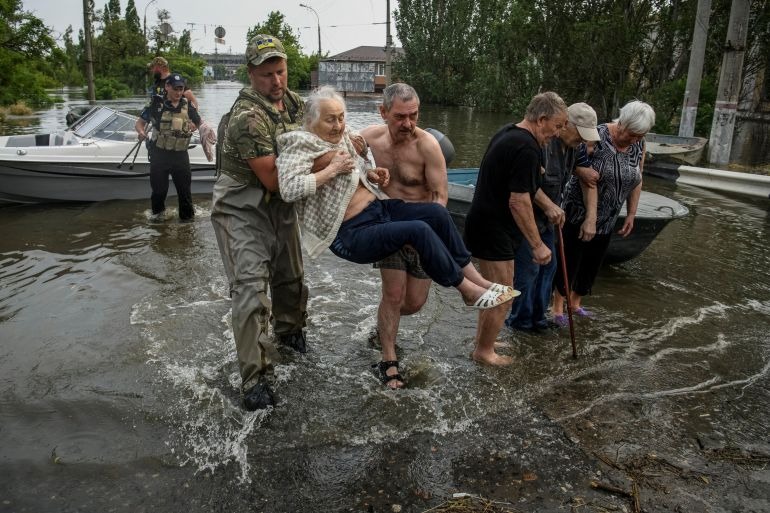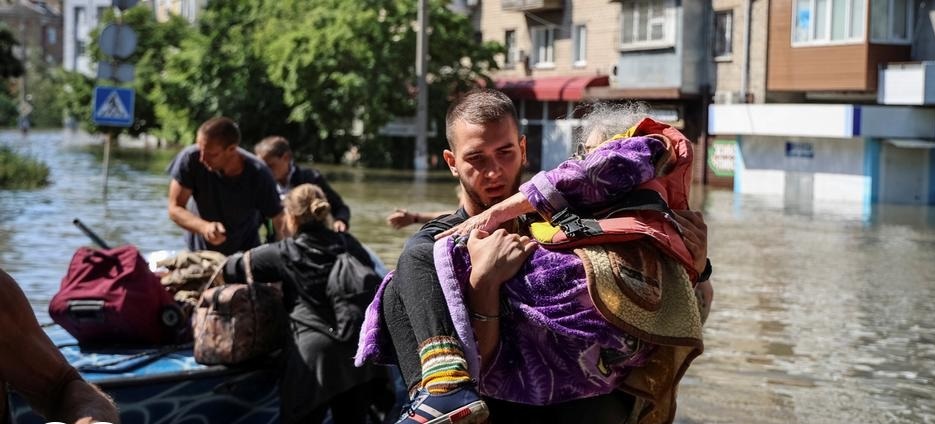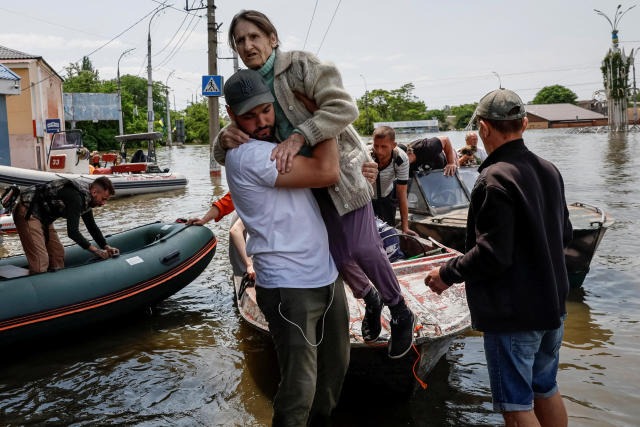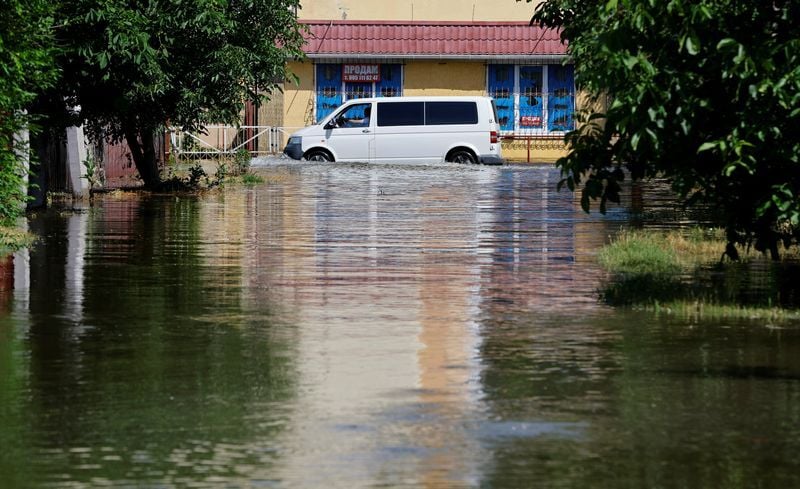
The available evidence indicates that Russia was responsible for the destruction of the extensive and critical dam. Now, amidst a brutal war, the arduous task of cleaning up and addressing the humanitarian, environmental, and potentially nuclear catastrophe lies ahead.
After four-and-a-half days since the bursting of Ukraine’s Nova Kakhovka dam, the true extent of the flooding disaster is slowly becoming clear. In Mykolaiv, the first city inland, pensioner Olena Lysiuk shares her experience, stating that despite living in an apartment that was not susceptible to flooding, she was forced to leave due to the lack of essential services like water, gas, electricity, and malfunctioning sewage systems. She plans to stay with relatives in Mykolaiv and has received some financial support from the government. Another evacuee, Vasyl Chornyi, disembarks from a train coming from Kherson, mentioning that although his village, Fedorivka, located 18 miles (29km) northeast of Kherson, was not directly affected by the flood, he is leaving due to concerns about a potential pandemic outbreak.
Chornyi grimly describes the dire situation caused by the flooding, stating that the cemetery and sewers have been completely submerged. He even recounts witnessing coffins floating downstream. Chornyi anticipates that once the waters recede, there will be a significant amount of dead fish and decay. He further adds that wells in Kherson have been contaminated, and outside toilets have been flooded. Interestingly, Chornyi acknowledges that despite enduring the Russian occupation from March to November, it is the catastrophic flooding that has ultimately compelled him to leave his home
Entire houses are being swept away and ending up in the Black Sea. An astonishing incident occurred on Friday when an intact roof was found on a beach in Odesa, approximately 130 miles away. Local residents have been advised against attempting to clean up the debris, reeds, and other waterborne waste due to concerns that landmines, some of which are made of lightweight materials, may be floating dangerously within. Consequently, the burden of cleaning up has fallen on the already overwhelmed state emergency services.

The interior ministry in Kyiv has reported 27 individuals missing thus far, although the actual number is expected to be significantly higher. This disaster has occurred at a critical juncture in the war since Russian troops were repelled from Kyiv. The day before the incident, Ukraine quietly initiated its long-awaited counter-offensive, which holds the future of the war, Ukraine, and possibly even Russia, in the balance.
Then, at 2:50 am on Tuesday, a cataclysmic event unfolded at the Nova Kakhovka dam. Local residents recounted hearing a deafening explosion that illuminated the sky in white during the early hours of the morning. Seismic analysis conducted by Norsar, a Norwegian organization utilizing sensors in Romania, has confirmed these reports thus far. Additionally, US media sources have indicated that spy satellites detected a blast around the same time. Experts suggest that destroying the dam from outside would have been significantly more challenging than detonating explosives from within.
If Russia is indeed responsible, as it appears to be the most likely scenario, the question arises: what could have motivated their forces? One explanation is that it could have been a defensive reaction driven by the perceived threat of an amphibious attack in the Kherson oblast, across the Dnipro River. It may have been a fearful response to the possibility of a surprise strike by Kyiv, spanning the country’s central and defining river.
Undoubtedly, a marine assault has become more challenging for Ukraine, and the construction of a pontoon bridge across the expanded Dnipro River is now nearly impossible. However, if the intention was to replicate Stalin’s destruction of the larger Zaporizhzhia dam in the face of the advancing German army in 1941, the consequences of Tuesday’s events would primarily impact civilians and, paradoxically, Russian soldiers on the left, southern bank of the Dnipro River, which is held by the invaders.
According to a group of Russian anti-war organizations, 1,842 residents in and around the flooded town of Oleshky, situated across the Dnipro River from Kherson, are currently being prevented from leaving by the Russian military. Among them, 338 individuals are in urgent need of assistance, as water and food supplies are dangerously scarce. The Red Cross has been unable to access the area, prompting these groups to appeal to the US government on Saturday to employ “diplomatic means” to alleviate the crisis.

However, it was the Russian forces who controlled the hydroelectric station situated atop the dam. During the occupation, Nova Kakhovka ceased its power generation operations and was transformed into a garrison. This strategic positioning allowed the Russians to repel any potential attempts by Ukrainian forces to approach the dam from the right bank.
There are additional indications that Russia viewed the dam as a pawn in a military maneuver, without clear consideration for the consequences. The Russian occupiers had permitted water levels in the Kakhovka reservoir, located behind the dam, to reach a 30-year high. The reservoir became filled with over 18 million cubic meters of water, equivalent in size to Utah’s Great Salt Lake.
The Ukrainian power company, which previously operated the hydro plant before it was taken over, also expressed concerns. Ihor Syrota, the head of Ukrhydroenergo, revealed that in late September and early October, Ukrainian workers at the station noticed a significant influx of explosive materials brought in by the Russians. However, by October, the Ukrainian workers were expelled, and the facility was transformed into a Russian military headquarters.
During an online meeting with environmental activists, President Volodymyr Zelenskiy emphasized Ukraine’s prior warnings to the international community regarding the potential mining of the dam and other critical infrastructure. He stated, “It was evident that Russia had the intention to cause a disaster.
An alternative explanation has emerged following the release of a recording by the Ukrainian security service on Friday. The recording purportedly captures a conversation between two Russian soldiers, wherein one soldier admits that it was a sabotage unit from their own side that triggered the explosion at the dam. The soldier further acknowledges that the resulting devastation exceeded their intended scope.
The authenticity of the recorded conversation remains unverified and likely unverifiable. However, if genuine, it supports the notion that the incident was a miscalculation, aiming to dislodge Ukrainian forces from the river islands that formed the no man’s land between the two banks.
Regardless of the motives behind the incident, the consequences are undeniable. While the immediate focus has been on the unfolding human and environmental tragedy downstream, an even larger catastrophe may be on the horizon in the upstream regions in the months and years to come.
At the conclusion of the week, the water level in the Kakhovka reservoir dropped to less than 12 meters, reaching what Ukrainian authorities referred to as the “dead zone.” This meant that the water level was insufficient to supply the four canal systems, remnants from the Soviet era, that irrigate the entire region, including Kherson and Zaporizhzhia oblasts, as well as Crimea. These regions are renowned as major agricultural hubs, and the Ukrainian Ministry of Agriculture cautioned that the absence of these vital canals could transform them into “deserts” as soon as next year.
The declining water levels in the reservoir pose a risk to the availability of drinking water for cities, towns, and villages situated along the lower course of the Dnipro River. Additionally, there is another potential threat, although less certain, that could have even more catastrophic consequences. The current water level in the Kakhovka reservoir is significantly below the required 13.3 meters needed to reach the intake channel of the Zaporizhzhia nuclear power plant, located approximately 125 miles upstream from the dam. Under normal circumstances, water would be drawn from the reservoir into spray ponds used for cooling the six reactor cores and the spent fuel stored at the plant. While the depletion of the reservoir is not an immediate danger, as all six reactors at Zaporizhzhia had been shut down after the plant was occupied by Russian forces and converted into a military facility, one of the reactors had been maintained in a state of “hot shutdown” to provide heat to the neighboring town of Enerhodar.
The Zaporizhzhia nuclear power plant has now been transitioned to a state of cold shutdown. The water requirements of the plant are significantly reduced compared to when it was fully operational.
In addition, there is a substantial cooling pond in place to address any emergencies. According to the International Atomic Energy Agency (IAEA), this pond holds a sufficient amount of water to sustain cooling operations for several months. Ukrainian officials from the Ukrainian nuclear energy corporation, Energoatom, are confident that the water supply in the pond is adequate for several years.

The potential consequences of the flooding include the risk of sewage contaminating the water extracted for drinking purposes, which, if not properly treated, could lead to various waterborne issues, with cholera being one of the most alarming concerns, according to Hunter. While cholera has not yet appeared in Ukraine, it has been known to emerge in war-torn regions, such as Syria. To prevent such problems, Ukraine is committed to implementing medical surveillance, vaccinations, and ensuring accessible healthcare for those who fall ill, Hunter explains.
In the aftermath of the dam destruction, the already high stakes of the Ukrainian counter-offensive have been raised to a new level. The Ukrainian troops faced a formidable challenge as they attempted to penetrate well-prepared Russian defensive lines, and reports of initial losses of Western military equipment, including German Leopard tanks and US-made Bradley fighting vehicles, began to circulate on social media.
Franz-Stefan Gady, a senior fellow at the International Institute for Strategic Studies, highlighted the unique nature of the Ukrainian forces’ tactical operation, emphasizing that, apart from the United States, no other Western military is currently capable of sustained combined arms operations at such scale. This further underscores the complexity of the situation.
The flooding has now exacerbated the crisis in Ukraine. The events that unfolded in the early hours of Tuesday morning not only plunged the country into war but also thrust it into an avoidable and man-made environmental and humanitarian catastrophe.



